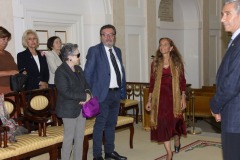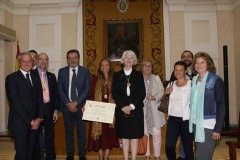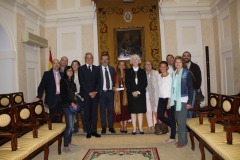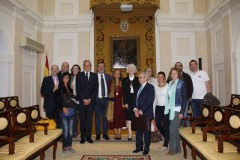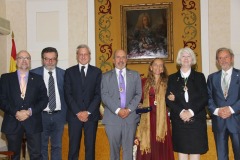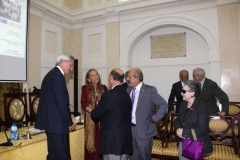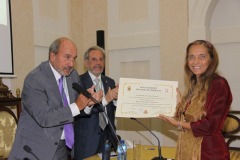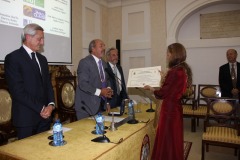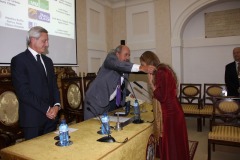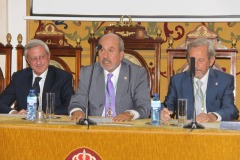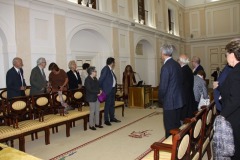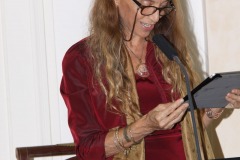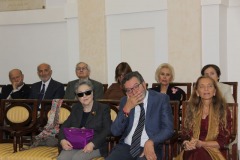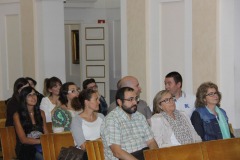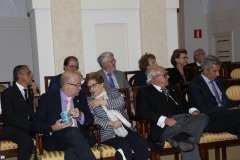Toma de Posesión como Académica Extranjera de Maria P. Abbracchio
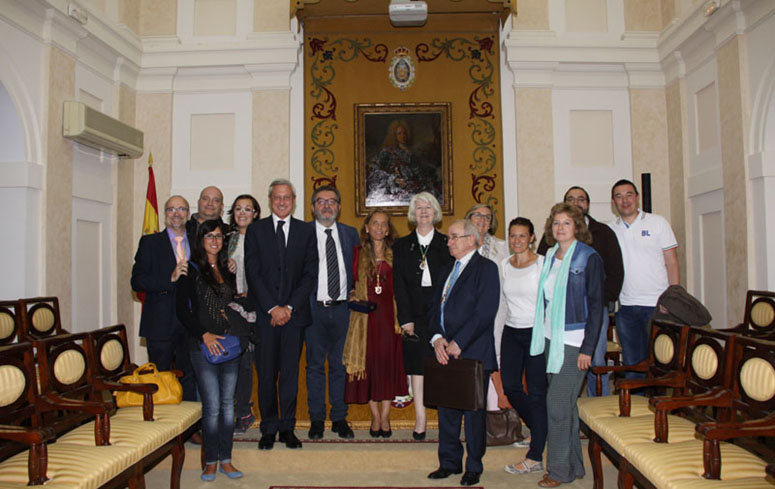
La Real Academia Nacional de Farmacia celebró la Sesión Pública el jueves 15 de septiembre de 2016 a las 19,00 horas, de Toma de Posesión como Académica Extranjera de Maria P. Abbracchio, PhD Professor of Pharmacology. President of the Research Observatory and President of the Filarete Foundation of theUniversity of Milan, Italy quien pronunció su discurso titulado: “Rejuvenating the old and diseased brain: the past, the present and the challenges of the future” “(Rejuveneciendo el cerebro viejo y enfermo: el pasado, el presente y los retos del futuro”) fue presentada por la Académica de Número de la RANF, Excma. Sra. Dña. Mª Teresa Miras Portugal.
Biografía
1
MARIA PIA ABBRACCHIO-SHORT Curriculum Vitae
Education
1979 Laurea “summa cum laude” (110/110 e lode) in Pharmacy, University of Milan, Italy
1984 Postdoctoral degree in Experimental Toxicology (Specializzazione in Tossicologia
Sperimentale), University of Milan
1988 Research Doctorate in Experimental Medicine (Dottorato di Ricerca in Medicina
Sperimentale), Rome
Appointments
1980-1981 Postdoctoral fellow, Department of Pharmacology, University of Texas, Houston, USA
1982-1988 Researcher (Ricercatore volontario), University of Milan
1990-1993 Research Assistant Professor (Ricercatore universitario, SSD: Bio14), University of Milan
1992-1993 “Honorary Research Fellow”, University College London, UK
1993-1998 Tenured Assistant Professor of Neuropsychopharmacology, University of Milan
1998-2002: Tenured Associate Professor of Pharmacology (Professore associato, SSD: Bio14),
University of Milan
2002-present: Tenured Full Professor of Pharmacology (Professore straordinario e dal 2005, Professore
ordinario di Farmacologia, SSD: Bio14/05G1), University of Milan
Main Scientific and Research Promoting Activities
1990 Member of the founding Committee of the “Purine Club”, a non-profit scientific
organization gathering basic and clinical scientists from 23 countries worldwide interested
in the pathophysiology of purines and pyrimidines
1991-2000 Councillor and Secretary of the Purine Club
1997-2001 Scientific Secretary of EPHAR, the Federation of European Pharmacological Societies
1991-present Scientific Secretary of international scientific meetings (including Purines ’92 and Purines
‘96, Milan, Italy, and the First European Congress of Pharmacology held in Milan in 1995)
1991-present Member of the Scientific Committee of international meetings including the Purines series
of conferences, the Italian-German Purine Club Joint Meetings, the 5th, 6th, 7th International
Symposia on Adenosine and Adenine Nucleotides, the 1st International Workshop on
Nucleotides and their Receptors in the Immune System (Ferrara, Italy, 2000) and the
Conference on Nucleotides and their receptors in the nervous system (Leipzig, Germany,
Aug. 1998). For details, see: Organization of International Conferences
2009-present Invited Member and, from 2015, COUNCILLOR OF GRUPPO 2003 PER LA
RICERCA SCIENTIFICA, a noprofit association gathering all Italian Highly Cited
Scientists aimed at fostering scientific research in Italy.
2003-2012 Member and, since 2006, President of the Committee for Pharmaceutical and
Pharmacological Sciences of the University of Milan, Italy
2006-present Official Member, Committee for Scientific Research and Technological Transfer,
University of Milan, Italy
2010-present Member, Patent Committee, University of Milan, Italy
Oct 2014-
present
PRESIDENT OF THE RESEARCH OBSERVATORY OF THE UNIVERSITY OF
MILAN, Italy (nominated directly by the University Rector Gianluca Vago)
June 2015-
present
Member of the Administration Council (CdA), and from June 28, 2016, PRESIDENT
OF THE FILARETE FOUNDATION, Milan, Italy, the Foundation for the Technological
and Knowledge Transfer of the University of Milan (nominated directly by the University
Rector Gianluca Vago).
2
Prizes/Honors/Recognitions and Awards
-In February 2014, awarded by President Giorgio Napolitano the grade COMMENDATORE
DELL’ORDINE AL MERITO DELLA REPUBBLICA ITALIANA (COMMANDER OF THE
ORDER OF MERIT OF THE ITALIAN REPUBLIC, the highest ranking honor order of the Republic)
for her scientific merits.
– In March 2016, nominated a MEMBER OF THE ACADEMIA EUROPAEA
– In 2006, awarded the HIGHLY CITED SCIENTIST recognition in Pharmacology and Toxicology
according to ISI Web of Science/Thomson Reuters, an international classification that captures the scientists
behind the most influential publications in all research fields (less than 0.5 percent of all publishing
researchers).
-From 2000-, OFFICIAL MEMBER OF THE IUPHAR (International Union of Pharmacology)
Subcommittee for P2Y Receptor Nomenclature and Classification, and from 2011-, COCHAIRPERSON
together with prof. G. Burnstock.
-Since 2003, INDEPENDENT EXPERT for the European Commission for the evaluation of research
grant applications for the Health area.
-In 1992-1993, HONORARY RESEARCH FELLOW, University College London, UK
-In 1988, awarded the ALDO CESTARI RESEARCH PRIZE IN PHARMACOLOGICAL SCIENCES
from the Italian Pharmacological Society for the best young pharmacologist curriculum of the year.
– Referee for international scientific journals and for public and private Research Institutions.
Below a list of main assignments in the last 10 years:
• From 2003, Independent expert for the European Commission (projects Adventure, NEST,
Shared cost, Cooperation, Innovation, etc)
• Italian Ministry of University and Research (MIUR: Progetti PRIN, CIVR, FIRB, ANVUR)
• Italian Multiple Sclerosis Foundation (FISM/AISM)
• National Institutes of Health, USA
• NATO
• Ontario Mental Health Foundation
• Canada Research Chairs Program
• International Human Frontier Science Program
• Biotechnology & Biological Sciences Research Council, UK
• Catalan Agency for Health Information, Spain
• French National Research Agency, France
-Experience in science communication to non-scientific public media (Newspapers, TVs) due to several
press releases (in both Italy and the USA, see Scientific American at:
http://www.sciam.com/article.cfm?id=controlling-cellular-gate&SID=mail), interviews and invitations in
public debates and television programs.
Publications, bibliometric indicators and most significant scientific achievements
During her carrier, Maria Abbracchio has authored/co-authored approximately 180 articles on peerreviewed
international journals and additional papers and monographies (total number of Web of Science
documents: 231), that have been cited approximately 10,000 times.
Bibliometric indicators of the scientific production according to InCites (Thomson Reuters, 2015):
H index: 63
Maria Pia Abbracchio is also Inventor in 7 patent applications, one of which has been granted in the
USA in March 2012 and another one has been approved in 2014.
Maria Pia Abbracchio has received grants as either Principal Investigator or Coordinator from national
(CNR, MIUR, Ministry of Health, Ministry of Foreign Affairs, Telethon, CARIPLO Foundation, FISM) and
international research agencies (e.g., European Commission). She has also acted as a Principal Investigator
in several grants from biotech and national and foreign Pharmaceutical Companies. Below a summary of the
most significant scientific achievements.
3
Main research interests deal with the mechanism of action of neurotransmitters and growth factors,
with emphasis on receptor-mediated modulation of cell growth, differentiation, survival and death. Maria Pia
Abbracchio has been studying for almost 3 decades the pathophysiological roles of extracellular nucleosides
and nucleotides, with special focus on inflammatory neurodegenerative events and to the set up of new
neuro-reparative strategies. She has also developed a significant expertise in the pathophysiology of glial
cells (astrocytes and oligodendrocytes, in particular), which has led her recent work to focus on the “stem”
cell properties of these cells after central nervous system damage and on the possibility of utilizing
purinergic ligands to induce these cells to generate new neurons and new glial cells in the diseased brain and
spinal cord. Seminal contributions to the field include:
o The proposal, together with Prof. G. Burnstock, of the currently utilized nomenclature for receptors responding to
extracellular nucleotides (Abbracchio MP & Burnstock G: “Purinoceptors: are there families of P2X and P2Y
purinoceptors?” Pharm Ther. 64:445-75, 1994). This proposal was later accepted by the IUPHAR Subcommittee
for Purinoceptor Nomenclature and Classification (Fredholm BB et al.: “Nomenclature and classification of
purinoceptors”, Pharm Rev. 46:143-56, 1994) and is now utilized by all scientists in the field.
o One of the first demonstrations that, in neuron-glia CNS cultures, purinergic agents induce reactive astrogliosis
(Abbracchio et al., Neurosci 59:67-76, 1994; Brambilla et al., Br J Pharmacol. 126:563-7, 1999) and influence the
differentiation of astrocytes by synergizing with growth factors (Abbracchio et al., Int J Dev Neurosci 13:685-93,
1995). These findings underline the role of these signaling molecules in astrocytic responses to trauma and
ischaemia, and have been confirmed by many other authors in a wide number of experimental models. These
findings are also particularly relevant to the demonstration that, in the adult CNS, neural stem cells belong to the
astroglial lineage and purines can crucially influence their final neuronal/glial fate by acting in synergy with peptide
growth factors.
o The first evidence that purines can regulate apoptosis in rat and human astrocytes (Abbracchio et al., Biochem
Biophys Res Commun 24:908-15, 1995; Ceruti et al., Mol Pharm 63:1437-47, 2003), in line with the importance of
purinergic signalling in astroglial proliferation and differentiation.
o One of the first position papers highlighting how prolonged neuroinflammation inhibits neurogenesis and
oligodendrogliogenesis in the damaged CNS (Marchetti & Abbracchio, Trends Pharm Sci, 26, 517-25, 2005),
delivering the concept that anti-inflammatory agents (including purinergic modulators), may exert neuroprotection
by relieving this inhibition, thus reinstalling neurogenesis and boosting local neuro-reparative responses in both
brain and spinal cord.
o The “deorphanization” of a new P2Y-like purinergic receptor (GPR17) activated by both uracil nucleotides and
cysteinyl-leukotrienes and acting as a “sensor of damage” in the CNS (Ciana et al., EMBO J. 25:4615-27, 2006;
Lecca et al., PLoS One 3:e3579, 2008; see Scientific American for press release at:
http://www.sciam.com/article.cfm?id=controlling-cellular-gate&SID=mail).
o The first demonstration that GPR17 plays a key role in the lineage specification of NG2 cells and in myelination
(Lecca et al., 2008; Fumagalli et al., J Biol Chem. 286:10593-604, 2011), in line with subsequent findings from
other authors (Chen et al., Nat Neurosci 12:1398-406, 2009). Based on the studies of the Abbracchio’s team, in
2012, the National Multiple Sclerosis Society USA has proposed GPR17 as a “model receptor” for novel
remyelinating therapies in neurodegenerative diseases.
More detailed information on Maria Pia Abbracchio’s research activity can be found at:
http://www.disfeb.unimi.it/ecm/home/ricerca/laboratori-ricerca/laboratorio-di-farmacologia-molecolare-e-cellularedella-
trasmissione-purinergica
Selected Recent Funding
– 2014-2016 Innovative re-myelinating strategies for multiple sclerosis via the exploitment of the new
oligodendrocyte receptor GPR17. Fondazione Italiana Sclerosi Multipla (FISM), N. 2013/R/1, PI.
– 2013-2016. “Restoring function in stroke via GPR17, a new receptor involved in adult brain self-repair
(RENEW IT)”. European Commission, ERANET-Neuron, Role: Co-PI with Prof. Elena Tremoli, 4 Partners.
– 2011-2013. New molecular basis for migraine: role of the purinergic system and of pain mediators in the
cross-talk between sensory neurons and neuro-inflammatory cells in trigeminal ganglia. Cariplo Foundation
Italy, PI and Coordinator of 2 units.
– 2011-2013. Innovative re-myelinating strategies for multiple sclerosis via the exploitment of the new
oligodendrocyte receptor GPR17. Fondazione Italiana Sclerosi Multipla (FISM), N. 2010/R/2, PI.
– 2011-2013. Implementing brain repair in stroke via the exploitment of adult neurogenesis and gliogenesis:
focus on the cross-talk between microglial and endogenous neural precursor cells. Italian Ministry of
Health, PI.
– 2010-2012. Studies of familial hemiplegic migraine transgenic mouse models and patients to investigate
the crosstalk between sensory neurons and neuroinflammatory cells in trigeminal ganglia in relation to
4
migraine pain. Italian Comitato Telethon, PI.
– 2008-2011. Purinoceptors and neuroprotection: focus on the new purinergic receptor GPR17. Italian
Ministry of University and Research N. 2008XFMEA3, PI and Coordinator of 5 units.
– 2008-2010. “Implementation of endogenous neurogenesis and gliogenesis via the purinergic system: a new
strategy to repair acute neurodegenerative disease”. Italian Ministry of Health, PI.
Selected patents
1. “Method for the diagnosis of heart disease” United States of America Patent application serial 10/156.352,
Filed on May 28, 2002, see: http://da.unimi.it/da/Brevetti/brevetti.doc_cvt.htm#bmk05
2. ”GPR17 modulators, method of screening and uses thereof” MI2004A 002007 (Oct 21 2004);
PCT/EP2005/011157 (Oct 21 2005); U.S.A. 11/665,835 (Nov 11, 2007) granted March 2012
3. “Composti e composizioni che modulano GPR17 e loro usi terapeutici e diagnostici” MI2010A002037
(October 10, 2010), extended internationally on October 10, 2011.
4. GPR1 7-MODULATING COMPOUNDS, DIAGNOSTIC AND THERAPEUTIC USES THEREOF,
PCT/IB20 11/054865
Selection of invited presentations at scientific meetings or at Academic/Private Institutions:
Maria Pia Abbracchio has delivered more than 100 oral presentations (mostly invited) and seminars. Here is
a selection of recent ones (last 10 years):
– Society for Neuroscience Annual Meeting, Atlanta, USA, Oct.14-18, 2006, Invited Speaker (press release
from the American Society for Neuroscience).
-Astra Zeneca, Molndal, Sweden, Nov. 22, 2006, Invited Seminar (Host of Dr. Hans vanGiezen).
-Second Joint Italian-German Purine Club Meeting, Leipzig, Germany, Sept. 12-15, 2007, Invited Speaker
-UCB Pharma, Chateau de Limelette, Belgium, Oct. 25, 2007, Invited seminar (Host of Dr. Alain Matagne,
Head of CNS Research Management Department).
-Annual meeting of the Hamilton Neurorestorative Group, McMaster University Health Sciences Centre,
Hamilton, Ontario, Canada, Jan 21, 2008, Invited Plenary Lecturer
– Purines 2008 Meeting, June 29-July 2, 2008, Copenhagen, Denmark, Invited Speaker
– American Society for Neurochemistry, Charleston, South Carolina, USA, March 7-11, 2009, Invited
Speaker
– Seminars on Genome Research, Helmholtz Zentrum München, Neuherberg, Germany, Apr 23, 2009,
Invited Seminar (Host of Prof. Magdalena Gotz, Director, Institute of Stem Cell Research)
– Sanofi-Aventis R&D, Paris, France, July 2, 2009, Invited Seminar (Host of Dr. Fabrice Viviani, Associate
Vice-President of Exploratory and Internal Medecine, Therapeutic Department, Discovery Research)
– Ceremony for the Medal and Honour Diploma to Prof. Geoffrey Burnstock, University of Ferrara, Italy,
June 4, 2009, Invited Plenary Lecturer
– “Fukuoka Purine 2009: International Symposium on Purinergic Signalling in New Strategy of Drug
Discovery”, Fukuoka, Japan, July 23-25, 2009, Invited Speaker
– “Ligand-gated cationic channels and G protein-coupled receptors in the nervous system“, Oct 7-9, 2009,
Leipzig, Germany, Invited Speaker
– Centre for Integrative Biology (CIBIO), Trento, Italy, May 12, 2010, Invited Seminar (Host of Dr. Sheref
Mansy, Researcher, and of Dr. Alessandro Quattrone, Director)
– 34° Congresso Nazionale della Società Italiana di Farmacologia, Rimini, Italy, 14-17 Sett. 2009, Invited
Speaker
– Congresso Nazionale della Società di Neuropsicofarmacologia, Cagliari, Italy, Sept. 22-25, 2010, Invited
Speaker
– Purines 2010, Adenine Nucleotides and Nucleosides in Medicine, Tarragona, Spain, 30th May–2nd June,
Invited Speaker
– Neuroscience Seminar Series, Max Delbrück Center for Molecular Medicine, Berlin, Germany, June 24,
2011, Invited Seminar (Host of Prof. Helmut Kettenmann, Director)
– 4thJoint German-Italian Purine Club Meeting, Bonn, Germany, July 22-25, 2011, Invited Lecturer
– 10th Euroglia Meeting, Prague, September 13-17, 2011, Invited Lecturer
– 23rd Biennial Meeting of the International and the European Society for Neurochemistry, Aug 28- Sept 1,
2011, Athens, Greece, Invited Lecturer
– UK Purine Club 2011 Symposium, November 2, 2011, Cardiff, UK, Plenary Lecturer
5
– Purine 2012, May 30-June 2, 2012, Fukuoka, Japan, Invited Plenary Lecturer
– 50th anniversary of the Hungarian Society for Experimental and Clinical Pharmacology, Sept 19-21, 2012,
Budapest, Hungary, Invited Lecturer
– Annual Purine Club meeting, Sept 13-14, Pisa, Italy, Invited Plenary Lecturer
– International Society for Neurochemistry/American Society for Neurochemistry meeting, April, 20-24,
2013, Cancun, Mexico, Invited Lecturer
– 36o Congresso Nazionale della Società Italiana di Farmacologia, Torino, Italy, Oct 23-26, 2013. Invited
Speaker
– Congresso Scientifico Annuale AISM e la sua Fondazione, Roma, Italy, May 28-29, 2014. Invited Speaker
– XVIII Congresso Nazionale della Società Italiana di Neuropsicofarmacologia, Torino, Italy, June 3-6,
2014, Invited Speaker
– Purines 2014, Bonn, Germany, July 23-27, 2014, Invited Speaker
– II International Congress on Purinergic Signaling in South America and V Meeting of the Brazilian Purine
Club, Maresias Beach, Brazil, May 30-June 2, 2015, Invited Plenary Lecturer
– European Society for Neurochemistry’s Conference Molecular Mechanisms of Regulation in the Nervous
System, Tartu, Estonia, June 14-17, 2015, Invited Speaker
– 6th Joint German-Italian Purine Club Meeting International Conference on Purinergic Signalling,
Hamburg, July 23-25, 2015, Invited Speaker
– 25th Meeting of the International Society for Neurochemistry, Cairns, Australia, Aug. 23-27, 2015, Invited
Lecturer, Symposium Organizer and Chair
– Paracelsus Medical University, Salzburg, Austria, Sept. 29, 2015, Invited seminar (Host of Prof. Ludwig
Aigner, Director, Institute of Molecular Regenerative Medicine.
– 16th Congress of the Italian Society for Neuroscience, Cagliari, October 8-11, 2015. Invited Speaker.
– 37th Congress of the Italian Pharmacological Society, Neaples, Italy, October 27-30, 2015, Invited Speaker
– Keystone Symposium on Purinergic Signaling, Vancouver, Canada, Jan 24-29, 2016, Vancouver, British
Columbia, Invited Speaker and Session Chairperson
– Evolution brings Ca2+ and ATP together to control life and death, 16-17 March 2016, The Royal Society
at Chicheley Hall, Buckinghamshire, UK, Invited Speaker
– 1st UK/Italian Purine Club Meeting, Sept. 13-14, 2016, Bristol, UK, Invited Speaker
Top 10 publications as senior author (2006-2016)
– Marschallinger, J, Schäffner, I, Klein, B, Gelfert, R, Rivera, FJ, Illes, S, Grassner, L, Janssen, M,
Rotheneichner, P, Schmuckermair, C, Coras, R, Boccazzi, M, Chishty, M, Lagler, FB, Renic, M, Bauer, HC,
Singewald, N, Blümcke, I, Bogdahn, U, Couillard-Despres, S, Lie DC, Abbracchio MP, Aigner, L. Structural
and functional rejuvenation of the aged brain by an approved anti-asthmatic drug. Nature Commun. 6:8466,
2015. I.F.: 11.47
– Viganò F, Schneider S, Cimino M, Bonfanti E, Gelosa P, Sironi L, Abbracchio MP, Dimou L. – GPR17
expressing NG2-Glia: Oligodendrocyte progenitors serving as a reserve pool after injury. Glia. 64(2):287-
99. doi: 10.1002/glia.22929, 2016. IF: 6.03
– Fumagalli, M, Bonfanti, E, Daniele, S, Lecca, D, Martini, C, Trincavelli ML, Abbracchio, M.P. (2015)
The ubiquitin ligase Mdm2 controls oligodendrocyte maturation by intertwining mTOR with G proteincoupled
receptor kinase 2 in the regulation of GPR17 receptor desensitization. Glia, 63(12):2327-39, 2015.
IF: 6.03
– Zaratin, P., Battaglia, M. A., and Abbracchio, M. P. (2014) Nonprofit foundations spur translational
research. Trends Pharmacol. Sci. 35, 552–5. I.F.: 11.54
– Ceruti S, Villa G, Fumagalli M, Colombo L, Magni G, Zanardelli M, Fabbretti E, Verderio C, van den
Maagdenberg AM, Nistri A, Abbracchio MP. Calcitonin gene-related peptide-mediated enhancement of
purinergic neuron/glia communication by the algogenic factor bradykinin in mouse trigeminal ganglia from
wild-type and R192Q Cav2.1 Knock-in mice: implications for basic mechanisms of migraine pain. J
Neurosci. 31: 3638-49, 2011. IF: 7.27
– Fumagalli M, Daniele S, Lecca D, Lee PR, Parravicini C, Fields RD, Rosa P, Antonucci F, Verderio C,
Trincavelli ML, Bramanti P, Martini C, Abbracchio MP. Phenotypic changes, signaling pathway, and
functional correlates of GPR17-expressing neural precursor cells during oligodendrocyte differentiation. J
Biol Chem. 286: 10593-604, 2011. IF: 5.33
6
– Ceruti S, Villa G, Genovese T, Mazzon E, Longhi R, Rosa P, Bramanti P, Cuzzocrea S, Abbracchio MP.
The P2Y-like receptor GPR17 as a sensor of damage and a new potential target in spinal cord injury. Brain.
132: 2206-18, 2009. IF: 10.0
– Di Virgilio F, Ceruti S, Bramanti P, Abbracchio MP. Purinergic signalling in inflammation of the central
nervous system. Trends Neurosci. 32: 79-87, 2009. IF: 12.79
– Abbracchio MP, Burnstock G, Boeynaems JM, Barnard EA, Boyer JL, Kennedy C, Knight GE, Fumagalli
M, Gachet C, Jacobson KA, Weisman GA. International Union of Pharmacology LVIII: update on the P2Y
G protein-coupled nucleotide receptors: from molecular mechanisms and pathophysiology to therapy.
Pharmacol Rev. 5: 281-341, 2006. IF: 16.85
– Ciana P, Fumagalli M, Trincavelli ML, Verderio C, Rosa P, Lecca D, Ferrario S, Parravicini C, Capra V,
Gelosa P, Guerrini U, Belcredito S, Cimino M, Sironi L, Tremoli E, Rovati GE, Martini C, Abbracchio MP.
The orphan receptor GPR17 identified as a new dual uracil nucleotides/cysteinyl-leukotrienes receptor.
EMBO J. 25: 4615-27, 2006. IF: 10.09
Maria Pia Abbracchio Milan, July 10th, 2016
Resumen
“Rejuvenating the old and diseased brain: the past, the present and the challenges of the future”
Lecture given by: Maria P. Abbracchio, PhD, Professor of pharmacology, President of the Research Observatory and President of the Filarete Foundation of the University of Milan, Italy
Due to the dramatic increase of the aging population, western countries,including Europe, are now facing the burden of new economic, societal and healthy challenges related to the management of neurodegenerative conditions like stroke, Alzheimer’s and Parkinson’s disease and chronic neurological disorders like multiple sclerosis (MS) or amiotrophic lateral sclerosis (ALS). Interestingly, recent data suggest that, irrespectively of their specific aetiopathology and clinical manifestations, all these diseases are invariably accompanied by an early loss of cognitive functions. There is thus an urgent need to identify new therapeutic approaches to both foster brain recovery after damage and, at the same time, prevent or ameliorate the associated cognitive decline. In the lecture, I will revise the seminal studies aimed at repairing and rejuvenating the brain, with special emphasis on the exploitment of stem cells for cell replacement and trophic regenerative therapies. I will highlight what we have learnt from the initial embryonic stem cells transplantation studies in Parkinson’s disease patients, to then revise the role of endogenous stem cells in brain functional recovery and end up with the current approaches aimed at combining biotechnological and pharmacological agents to properly instruct these cells to repair the brain. A special focus will be devoted to therapeutic approaches ameliorating cognitive abilities to contrast pathological aging and brain functional deterioration.

